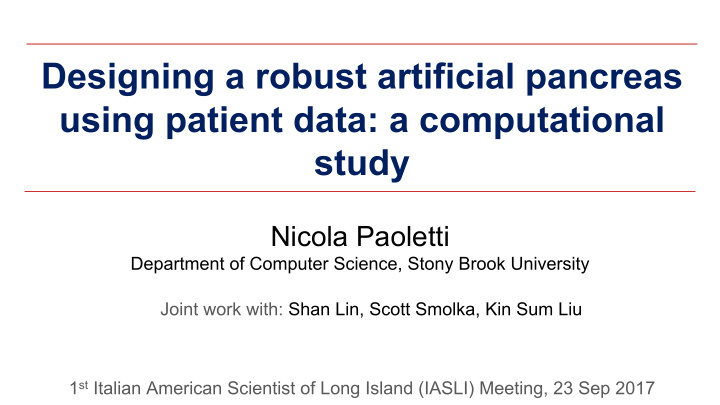



Designing a robust artificial pancreas using patient data: a computational study Nicola Paoletti Department of Computer Science, Stony Brook University Joint work with: Shan Lin, Scott Smolka, Kin Sum Liu 1 st Italian American Scientist of Long Island (IASLI) Meeting, 23 Sep 2017
Diabetes WHO Global report on diabetes, 2016
Type 1 diabetes (T1D) T1D HYPERGLYCEMIA Blood glucose Healthy SAFE RANGE HYPOGLYCEMIA Time Meal
Type 1 Diabetes (T1D) therapy – Insulin pumps - Devices for continuous insulin infusion, with 1M T1D users estimated worldwide (source: American Diabetes Association) - More accurate therapy à better glucose profile than injections - It delivers two kinds of insulin: - Bolus : high, on-demand dose to cover meals - Basal: to cover demand outside meals
T1D therapy – Continuous Glucose Monitor - Continuous Glucose Monitor (CGM) detects sugars levels under the skin, a measure of blood glucose (BG) - It reads glucose levels every 5 minutes and sends them wirelessly to display devices - Fingerstick measurements no longer needed (only for calibration)
T1D therapy – limitations CGM - Pump and CGM don’t communicate with each other PUMP - Bolus is manually set by the patient → danger of wrong dosing
Closed-loop control, aka Artificial Pancreas (AP) Sugar levels CGM Challenges à CGM is a “derived” measure of PUMP Glucose/ BG (and noisy) Insulin metabolism à Disturbances related to patient behavior (Meals and Exercise) NOT JUST MEDICAL BUT ALSO AN ENGINEERING CHALLENGE
Artificial Pancreas, a control problem T1D + T1D therapy Problem: Blood glucose Automatically find the insulin Healthy therapy (amount and timings) that best keeps blood glucose (BG) “in range” Insulin
Our idea - Use data to get an overall picture of the patient à learn data-driven models of meal and exercise behavior - Such models make the controller robust to uncertainties due to patient’s daily activities Mathematical abstraction Meal/exercise data (captures all input data with statistical (questionnaires, surveys, sensors, …) guarantees) Carbs (mmol/min) Time (min)
In-silico Artificial Pancreas: overview sensing uncertainty noise - Controller computes “optimal” CGM Virtual T1D insulin based on an internal output insulin + Controller patient predictive model of the system. - T1D patient model is a “high- fidelity” mathematical model of uncertainty State sets "likely" glucose/insulin metabolism patient state estimator - State estimator derives from CGM measurements the internal state of the patient model, detecting meals Data-driven "likely" meal and exercise. It uses a predictive learning and exercise data model too - Data-driven learning computes initial meal and exercise data mathematical abstractions of patient behavior for controller and estimator
Evaluation Our robust controller compared with - Perfect controller: with exact knowledge of meal and exercise behavior, and full state observability (no state estimation errors) - “Hybrid closed-loop” controller: considers only glucose measurements and not patient behavior
Virtual patient learnt from NHANES database GROUP 1: Carbs-rich breakfast - We learn patient models from CDC’s NHANES Carbs (mmol/min) - Meal data from 8,611 participants - We cluster data into 10 main groups (finer classification is possible) 14 Time (min) 12 BG (mmol/L) T hypo T in range T hyper 10 8 Perfect 0% 100% 0% 6 18.5 % 80.97 % 0.53 % Hybrid closed- 4 loop 2 2.02 % 0 500 1000 Robust 93.45% 4.52% Time (min)
Scenario 1 - Meals as expected Carbs (mmol/min) Situation where uncertainty set (gray box) is accurate BG (mmol/L) 15 T hypo T in range T hyper 10 Perfect 0% 99.69% 0.31% 5 Hybrid closed- 1.6% 69.4% 29% loop 0 0 50 100 150 200 250 300 Robust 0.51% 97.7% 1.79% Time (min)
Scenario 2 - Unexpected delays in meals Carbs (mmol/min) Situation where uncertainty set is NOT accurate BG (mmol/L) 15 T hypo T in range T hyper 10 Perfect 0% 100% 0% 5 Hybrid closed- 0% 67.25% 32.75% loop 0 0 50 100 150 200 250 300 Robust 0.79% 99.03% 0.18% Time (min)
Scenario 3 - Outliers Carbs (mmol/min) Situation where the virtual patient behaves far from the average case (both meal size and timing) BG (mmol/L) 15 T hypo T in range T hyper 10 Perfect 0% 100% 0% 5 1.03% 81.51% 17.45% Hybrid closed- loop 0 0 50 100 150 200 250 300 Robust 0.28% 84.19% 15.53% Time (min)
Scenario 4 – High carbs intake, 2 days Typical settings to test robust AP controllers BG (mmol/L) 15 T hypo T in range T hyper 10 Perfect 0% 99.52% 0.48% 5 1.55 % 80.6 % 17.85 % Hybrid closed- loop 0 0 4 8 12 16 20 0 4 8 12 16 20 3.11% Robust 87.56% 9.33% Time (h)
Summary - Robust controller design for insulin therapy that well supports meal disturbances - Based on learning mathematical representation of patient data - Evaluated on “synthetic” scenarios and real data - A step towards exploiting data deluge from sensors and smart devices for medical applications Ongoing and future work - More advanced patient behavioral model - Interplay between insulin control and recommendations
Recommend
More recommend